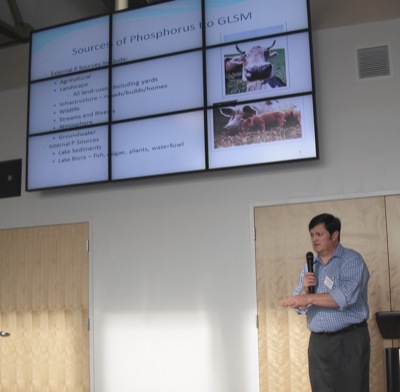Tuesday, March 22nd, 2011
Alum treatment expected to lessen lake's algae blooms
By Nancy Allen

Photo by Nancy Allen/The Daily Standard
Consultant Harry Gibbons talks about Grand Lake's toxic blue-green algae during a public meeting Monday night at Wright State University-Lake Campus.
GRAND LAKE - The state won't be able to use the optimum amount of alum to treat Grand Lake this spring, but it should be enough to lessen toxic algae blooms this summer.
"Will you see more clarity? Yes. Will you see less algae? Yes. Will you see a crystal-clear lake? No," consultant Harry Gibbons said during a meeting Monday at Wright State University-Lake Campus.
The alum the state will distribute represents about 18 percent of the amount needed for a whole-lake treatment, he said. Limited funding is restricting the state's efforts.
Gibbons works for Tetra Tech, the firm the state hired to conduct a first round of alum tests in the lake last summer. Alum inactivates phosphorous - algae's main food source.
About 60 people attended the public meeting Monday to hear about a whole-lake treatment. The Ohio Department of Natural Resources is applying for $5 million from the Ohio EPA Water Pollution Control Fund to pay for it with a request for principal forgiveness, meaning the loan would not need to be repaid. The meeting was required for the loan process.
Gibbons said the whole-lake treatment would begin in May and take about 45 days. He said a higher dosage of alum will be applied in the middle of the lake to attack phosphorous in the sediment. A lower dosage will be applied around the entire shoreline to attack phosphorous suspended in the water column.
The middle portion also will be pretreated with hydrogen peroxide, which strips phosphorous from organic matter, sediment and algae, said ODNR spokesman Scott Fletcher. This allows the phosphorous to bind to the alum.
Ongoing, small-dosed alum treatments will be needed in the lake for some years until conservation fixes on the land start reducing phosphorous runoff, Gibbons said. Alum is being used as a short-term solution. The lake was nearly shut down last summer after the state recommended no contact with the water due to massive toxic algae blooms.
Fletcher said ODNR has received tentative approval on the loan.
The state began advertising for bids for the whole-lake treatment Saturday. Greg Smith, who works with the EPA loan program, said if approved, the loan would be awarded about May 1.
The state also will do a second round of alum testing at three sites between April 5 and 12. The sites are the west beach near the state park office, which will receive granular alum; the state park campground lagoon, which will be pretreated with hydrogen peroxide and then receive liquid alum; and the Windy Point east channel, which will receive a higher dose of liquid alum. Just one company has responded to bid for the test project, Fletcher said. The company's name will be released after it is approved by the state controlling board, likely some time this week.
The test sites will be used to fine-tune future treatments, Gibbons said.
A first round of alum testing done last summer used liquid alum only and produced phosphorous reductions, but not as much as state officials had hoped. Those analyzing the results recommended the second test be done during cooler temperatures with a hydrogen peroxide pretreatment to better help the alum work.
Gibbons told the crowd efforts to clean Grand Lake will take many years.
"You're going to be at this a long time," he said.
Alum facts:
A question and answer session also was held during the meeting Monday.
Q: If the loan is approved with principal forgiveness this year and the alum dosage amount is working, from where would additional funds to continue treatments come?
Smith: "I feel comfortable we could continue to approve loan funds, but loan funds with principal forgiveness, I don't know."
Principal forgiveness is a new component of the loan program available for the first time this year. It was approved by Congress to address a situation deemed as an emergency and serious public health threat.
Q: Why will a higher alum dosage be used in the middle of the lake?
Gibbons: Because sediment core samples there showed much higher levels of phosphorous than around the shoreline.
Q: If the lake is treated with alum this year, what is the probability of another summer of toxic algae blooms?
Gibbons: It is still probable there will be a bloom, but with less intensity and for a shorter duration.
Q: Based on your (Gibbons') experience fixing other bodies of water, how long do you think it will take to fix Grand Lake with ongoing alum treatments?
Gibbons: An alum dose can last two to 20 years. How long it will last depends on how fast the phosphorous is replaced from runoff that keeps coming into the lake.

